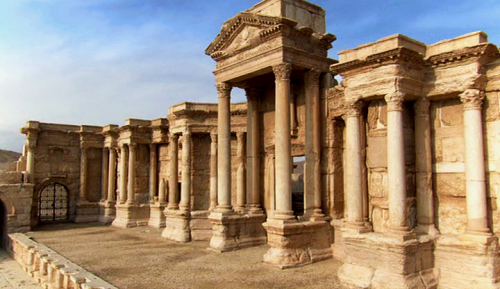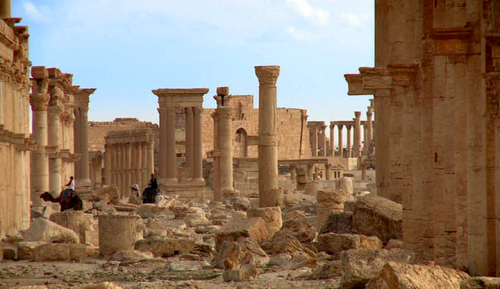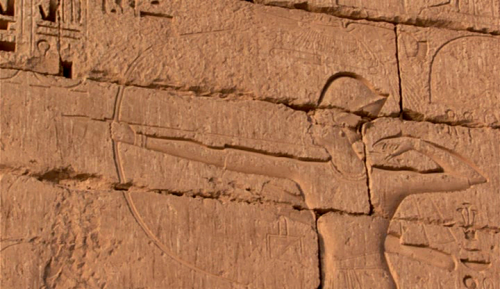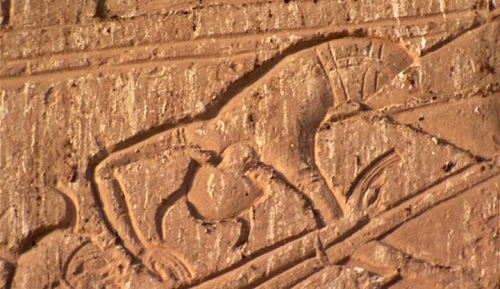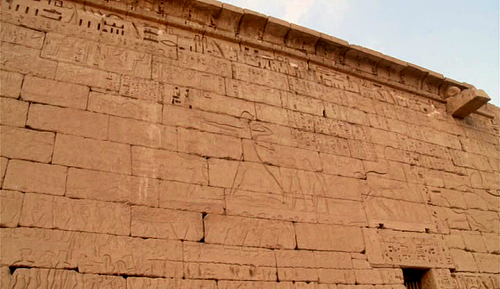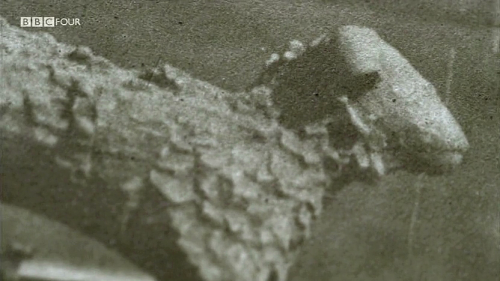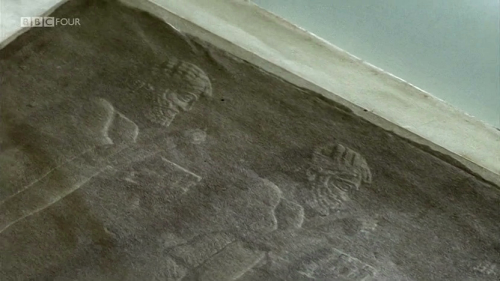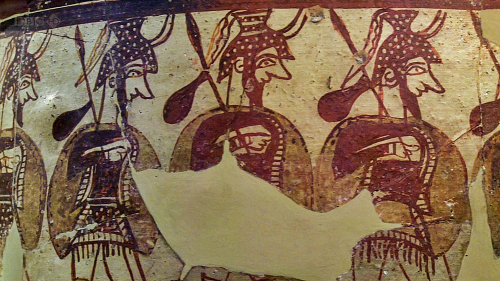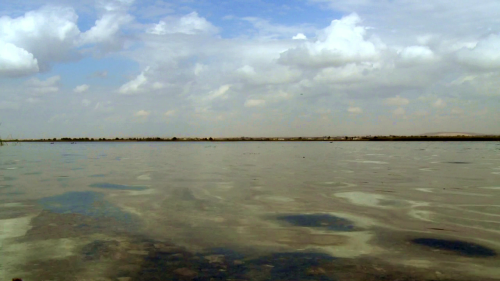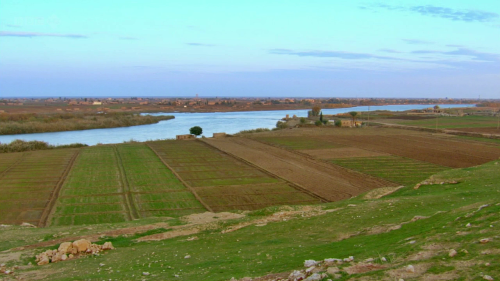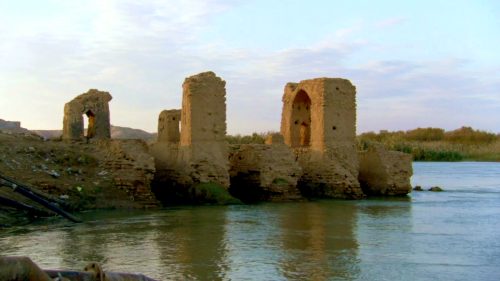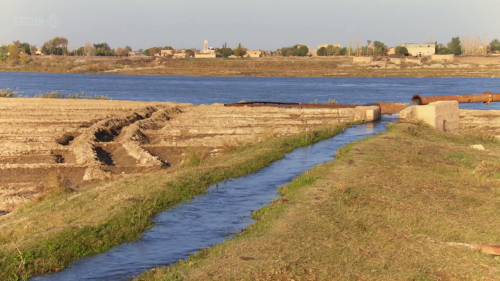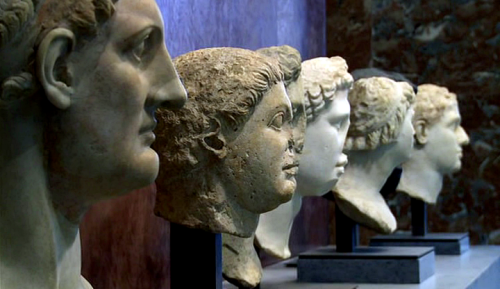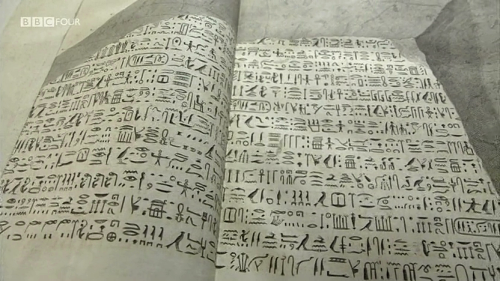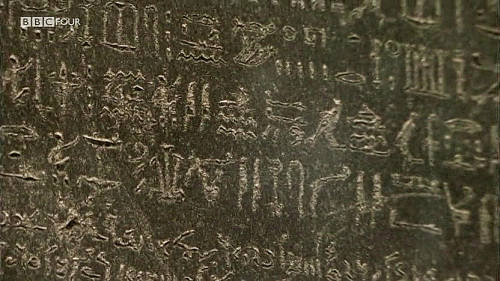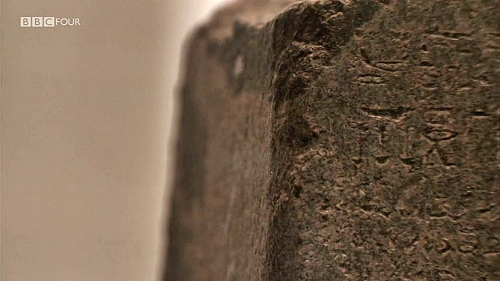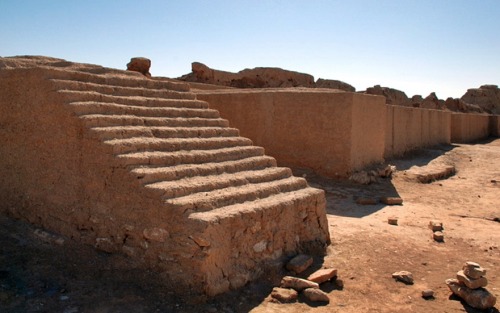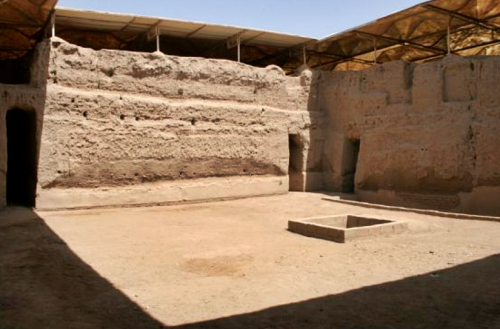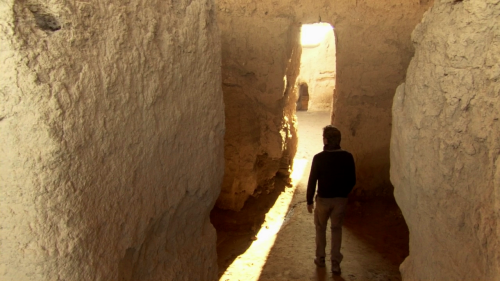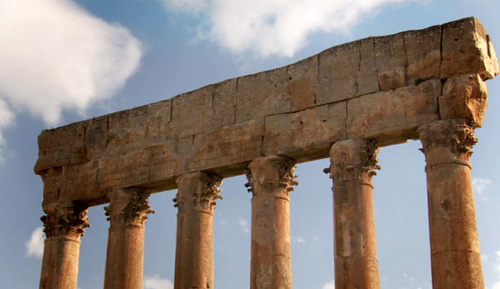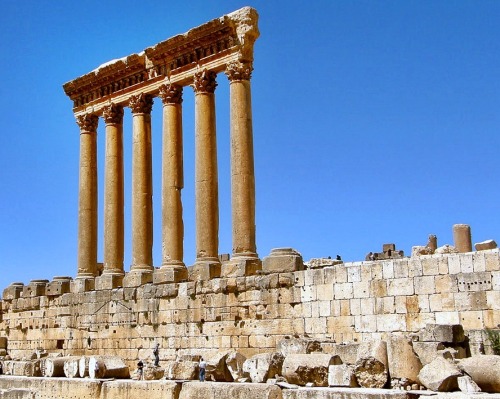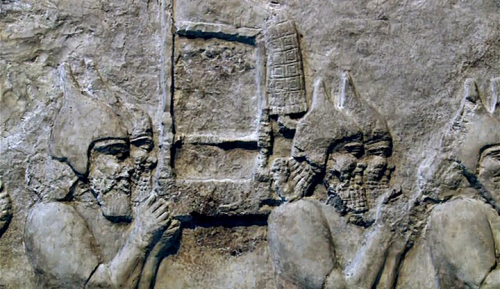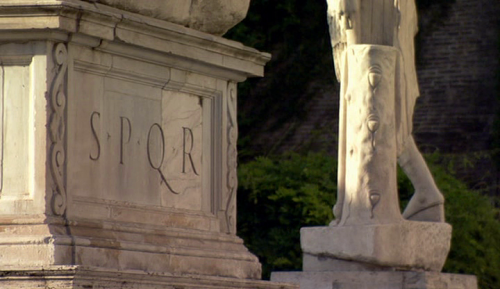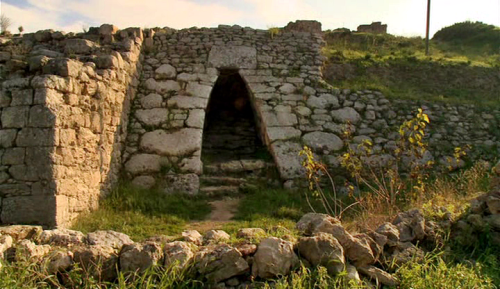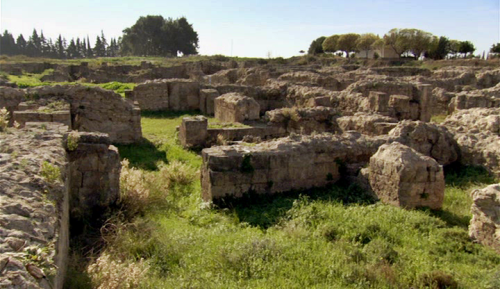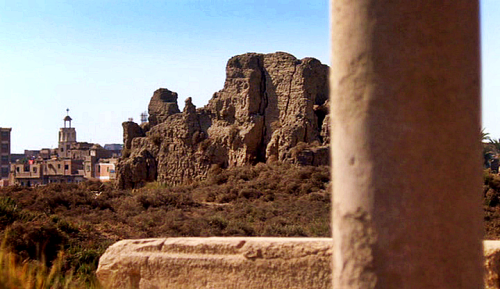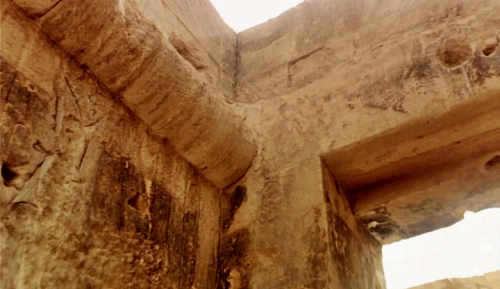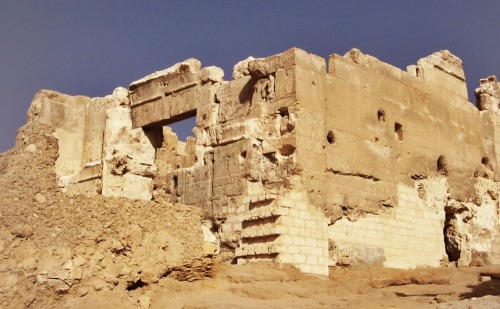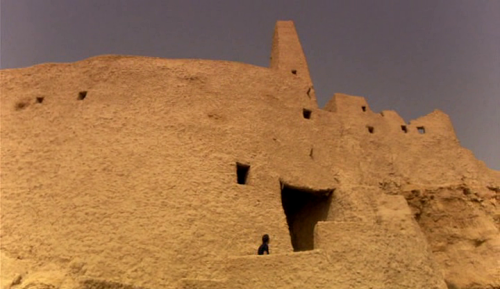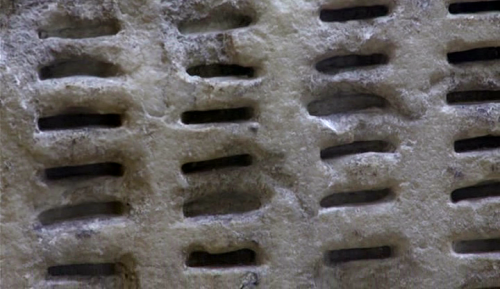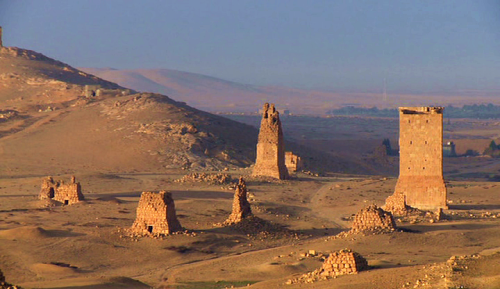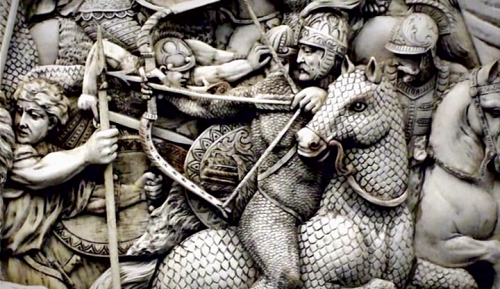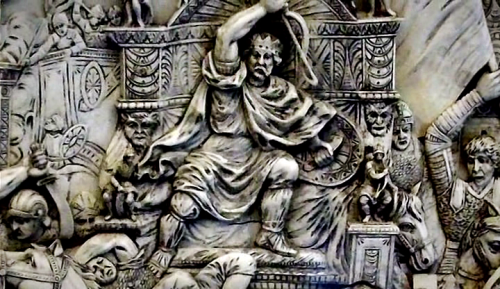#richard miles
Ancient Worlds - BBC Two
Episode 6 “City of Man, City of God”
Palmyra2010
Part II
Palmyra, Syria
Post link
Ancient Worlds - BBC Two
Episode 6 “City of Man, City of God”
Palmyra2010
Part I
Palmyra, Syria
Post link
Ancient Worlds - BBC Two
Episode 2 “The Age of Iron”
Medinet Habu, The Mortuary Temple of Ramesses IIIatThebes.The temple decoration consists of a series of reliefs and texts paying tribute to the pharaoh and his many accomplishments. The murals depicting the battles between Egypt and the Sea Peoples (about 1190 BC) are located on the northern outside wall of the temple.
The texts and reliefs regarding the Sea Peoples provide an account of Egypt’s campaign against the “coalition of the sea” from an Egyptian point of view. Rameses III is depicted with his bow drawn, gigantic, while the warships of the invaders gather around his feet; it is a triumphant, propagandistic image of total annihilation. The inscriptions of the pharaoh at his temple record three victorious campaigns against the Sea Peoples.
According to Egyptian accounts the Sea Peoples, a group of distinct peoples of diverse origins, were named as the Peleset, Tjeker, Shekelesh, Denyen, Habiru and Weshesh. Scholars have tried to identify these places as mainland Italy, Sardinia, Sicily, the islands of the Aegean, Palestine and even Minoan Crete and Anatolia, but such claims still remain mere conjecture. The Medinet Habu reliefs provide valuable information about the appearance and accoutrements of the various groups.
Egypt was one of the few civilizations that managed to survive the onslaught of the Sea Peoples but in the following years they appeared in greater numbers, leaving the Egyptians more vulnerable, incapable of defending their possessions in the East.
Medinet Habu, Theban Necropolis, Luxor, Egypt
Post link
Archaeology: A Secret History - BBC Four
Episode 2 “The Search for Civilisation”
Some of the very first archaeological photographs held in Les Archives Nationales-French National Archives. The pictures were taken in ancient Mesopotamia,Iraq, during a French expedition in the early 1850s.
Some of those photographs are very important because what we see on the photograph actually got lost on the way to France (in a river). All we have now is the photograph of some of these objects. Thanks to these images archaeologists still can work with this lost material.
French National Archives, Paris, France
Post link
Ancient Worlds - BBC Two
Episode 1 “Come Together”
KraterfromMycenae,Greece, known as the Warrior Vase.
Late Helladic period (late Bronze Age), 1200-1100 BC.
The painted terracotta vase was found by Heinrich Schliemann on the acropolis of Mycenae. During the 1870s Schliemann excavated the ancient Shaft Graves, a royal cemetery, where he discovered spectacular grave goods.
The large vase depicts a group of heavily armed warriors (helmet, cuirass, greaves, shield and spear) as they depart for war, a sack of supplies hanging from their spears. A woman, standing to one side, bids them farewell. It is one of the best known examples of Mycenaean Pictorial style
Ancient greeks used kraters to mix wine and water.
National Archaeological Museum, Athens, Greece
Post link
Ancient Worlds - BBC Two
Episode 1 “Come Together”
TheEuphrates is the longest river in southwest Asia and one of the most historically important rivers in the world. The Euphrates rises in Turkey and flows southeast across Syria and through Iraq. Along with the river Tigris, it provided much of the water that supported the development of ancient Mesopotamianculture.
The Tigris Euphrates valley was the birthplace of the ancient civilisations of Assyria, Babylonia,Sumer and the Akkadian Empire. The ancient Greeks called that region Mesopotamia “the land between two rivers” (Tigris/Euphrates). People had occupied that marginal land for 1.000 years before the first cities appeared. They arrived as pastoralists with their herds; they stayed on as farmers close to the river banks in scattered communities of 1.000 or 2.000 people at most. Around 3.100 BC Southern Mesopotamia experienced a growth in the number and size of settlements, suggesting strong population growth. People left the security of their family compounds and tribal villages and they came together with other strangers to create something far more complex: a city, a society, a civilisation. Many of these city-states were located along canals of the Euphrates and the Tigris. A similar development, although on a smaller scale than in Lower Mesopotamia, took place in Upper Mesopotamia in the second part of the 3rd millennium BC.
All the ancient civilisations of the world have flourished near the river beds The Tigris Euphrates river system is one of the four river civilisations where writing was invented, along with the Nile valleyinEgypt (Nile River), the Indus Valley civilisation in the Indian subcontinent (Indus River), and the Yellow RiverinChina.
Post link
Ancient Worlds - BBC Two
Episode 4 “Return of the King”
In the wake of Ptolemy’s I takeover of Egypt(around 323 BC), an estimated 150.000 Greeks moved to Alexandria to be close to this new source of power and patronage. Alexandria became the capital city and a major center of Greek culture (Greek was the official language under the Ptolemies) and trade. The traditional gods were still worshipped but new gods were also introduced, like Serapis, a composite of several Egyptian and Hellenistic deities.
The Ptolemies were generous supporters of artists, and they used their freedom to treat the human form with daring realism. For the first time, there were museums and great libraries, such as those at Alexandria (Great Library of Alexandria) and Pergamon.Marble was a fantastic medium for showing the human form. Some of the best known sculptures from the ancient world are products of this period.
The Roman province of Egypt was established in 30 BC after Octavian (later emperor Augustus) defeatedMark Antony, deposed his lover Queen Cleopatra VII and annexed the Ptolemaic Kingdom to the Roman Empire.
Several exquisite pieces dating back to the Hellenistic, RomanandByzantine eras were discovered during excavations in the site of the construction of the New Library of Alexandria. These works reflect the rich, multi-cultural history of Egypt with its Pharaonic, Graeco-Roman, Coptic and Islamic heritage.
Antiquities Museum, Alexandrine Library, Alexandria, Egypt
Post link
Archaeology: A Secret History - BBC Four
Episode 2 “The Search for Civilisation”
TheRosetta Stone was found on July 19, 1799, during Napoleon Bonaparte’s Egyptian campaign by French soldiers near the town of Rosetta (el-Rashid, about 65 km north of Alexandria). It contained fragments of passages written in three different scripts: Greek,Egyptian hieroglyphicsandEgyptian demotic.
On Napoleon’s defeat, the Rosetta Stone became the property of the British under the terms of the Capitulation of Alexandria (1801) along with other antiquities that the French had found. Before being put on public display, the stone was sent to the Society of AntiquariesinLondon to be copied. Four plaster-cast copies were made and distributed to four universities: Oxford, Cambridge, Edinburgh and Dublin. Hundreds of prints were produced and spread across Britain, sent to both individuals and to institutions. Direct copies were also made from the stone itself; ink was smeared over its surface before paper was laid down on it and the inscriptions were coloured in white chalk to make them more legible. Several scholars made progress with the initial hieroglyphics analysis but it was 20 years, however, before the transliteration of the Egyptian scripts was announced by Jean-François Champollion in Paris in 1822.
The decoding of the Rosetta Stone was a massive advance. It provided the key to the modern understanding of Egyptian hieroglyphs and the chronology of Egyptian history.
Today the Rosetta Stone is an archaeological icon and one of the treasures of the British Museum.
Pictures 1-2: A copy of an engraving of the Rosetta Stone, done in the Society of Antiquaries in 1801
Post link
Ancient Worlds - BBC Two
Episode 1 “Come Together”
Mari (modern Tell Hariri, in Syria) was an ancient Mesopotamian city on the western bank of the Euphrates river and one of the hegemonic states of the area during the 3rd and early 2nd millennia BC. The city flourished as a trade center; it was strategically important as a relay point between the Sumerian cities of lower Mesopotamia,Babylon, the Levant,EgyptandPersia.
Archaeologists have discovered a wealth of prestigious palaces and temples, art schools and an exceptional quantity of administrative archives dating back to the last periods of the city. More than 25.000 clay tablets in Akkadian language written in cuneiform were discovered (The Mari Tablets).
TheRoyal Palace of Mari was the royal residence of the rulers of the ancient kingdom. King Zimri-lim (reigned from about 1779-5 to 1761 BC) expanded the palace which was possibly the largest at the time. It contained more tan 200 rooms, several statues and exquisite artefacts. The throne room was designed like a temple, its walls covered with brilliantly coloured frescoes. The palace even had its own ice-house so that the king’s honey-sweetened wine could be served cold.
Mari was destroyed by Hammurabi, king of Babylon(this is known from the numerous state archives tablets that recount Hammurabi turning on his old ally king Zimri-lim). After this destruction the city was inhabited sporadically but it never regained its former status.
Mari, Tell Hariri, Syria
Post link
Ancient Worlds - BBC Two
Episode 6 “City of Man, City of God”
TheTemple of Jupiter Baal, in Baalbek.
ThePhoenician city of Baalbek was known as Heliopolis (the city of the Sun) during the Hellenistic period.
The city became an important religious center during Greco-Roman times and it was one of the largest sanctuaries in the Roman Empire.
The greatest temple of the city was sacred to Jupiter Baal, (Heliopolitan Zeus), identified with the Sun. The Jupiterworshipped there was also understood to be Baal-Hadad, a local storm deity who had been honoured for centuries. The temple was constructed during the 1st century AD (completed circa 60 AD) on top of a podium and foundations presumably from a previous ancient temple. The temple had more than 50 Corinthian columns, 20 meters high, but today only six columns remain standing.
Baalbek, with its colossal structures, is one of the finest and most impressive examples of Imperial Roman architecture.
Baalbek, Lebanon
Post link
Ancient Worlds - BBC Two
Episode 2 “The Age of Iron”
Detail-Assyrian stone wall panel from the Central Palace of Nimrud (Kalhu), Northern Mesopotamia(Iraq). It dates to 728 BC.
KingAshurnasirpal II (reigned 883 - 859 BC), moved the Assyrian court to Nimrud and the city became the administrative center of the empire and the king’s residence. Ashurnasirpal’s most impressive building was his new royal palace, the Northwest Palace. A citadel that housed the palace and several temples of the most important deities of Assyria were built. Nimrud was protected by a 7,5 km long fortification wall.
King Tiglath-Pileser III (ruled 744/5–727 BC) built a new royal palace, known today as the Central Palace. He had his royal annals engraved across the bas-reliefs depicting his military achievements on the sculptured slabs decorating his palace. Parts of those wall decorations are today housed in the British Museum.
British Museum, London
Post link
Ancient Worlds - BBC Two
Episode 5 “The Republic of Virtue”
SPQR “Senatus Populusque Romanus” (Senate and people of Rome)
This phrase was the source of all authority for the actions of the Roman Republic. The date of establishment of the official monogram of the Republic is unknown (but it cannot be dated earlier than the foundation of the Republic). It first appears in inscriptions of the Late Republic and continued in use under the Roman Empire.
The Senate and the Roman people, the two entities mentioned, are sovereign when combined. However, where Populus is sovereign alone, Senatus is not. The Romans believed that all authority came from the people; the Roman people appear very often in law and history. SPQR was a reminder of the new republic after noblemen overthrew the corrupt kings. SPQR made Roman citizens feel as if they had a voice and control in the government but it also masked all the unresolved tensions between the strong and the weak, the powerful and the powerless.
SPQR was inscribed on Ancient Roman public buildings, on the base of the legion’s eagle standards, money, and public places.
The initials are used as an official emblem of the modern-day municipality of Rome and can still be seen all over the city today.
Rome, Italy
Post link
Ancient Worlds - BBC Two
Episode 1 “Come Together”
Thegold helmet of Meskalamdug (c. 2400 BC)
The helmet was found in the Royal Tombs of Ur, in PG 755 by the British archaeologist Leonard Woolley. It belongs to the early dynastic period, the first Dinasty of Ur.
King Meskalamdug was not mentioned on the Sumerian king but his son, Mesannepada was the first king listed. Many of the artifacts found in tomb PG 755 bear the name of Meskalamdug but the cylinder seal of Meskalamdug was found in a larger tomb (PG 1054). Woolley believed that the smaller tomb was not the tomb of king Meskalamdug, but it perhaps belonged to his grandson, an elite, but not necessarily a king. The distinctive helmet was the kind of helmet usually worn by lords and kings and it had a ceremonial purpose.
The helmet was made from a single piece of gold and fashioned to look like hair. In the back of the helmet there is a small hollow bump, used to hold the hair of its owner (in a bun) and it has holes in the ears.
The helmet on the picture (British Museum) is an electrotype copy of the original helmet -which was in Baghdad, in the National Museum of Iraq.
The British Museum, London, UK
Post link
Archaeology: A Secret History - BBC Four
Episode 2 “The Search for Civilisation”
The Group of the Cross is a complex of temples at the Maya ruins of Palenque, Mexico.
Palenque was a Maya city state that flourished between 500 and 700 AD, when the city rose to be a powerful capital within a regional political unit. K'inich Janaab’ Pakal -Pakal the Great-, was the most famous ruler of Palenque. Once the ancient city was abandoned around the 9th century, the thick jungle surrounding it covered its temples and palaces.
The temples known as the Cross Group are among the most elegant of all Maya architecture. The three main structures are the Temple of the Cross (picture n 1), the Temple of the Sun (picture n 2, left) and the Temple of the Foliated Cross (picture n 3).
The temples were built from limestone, covered in stucco and decorated with blue and red paint. All three temples (built between 684 - 702 AD) have a large central opening flanked on each side by two stucco decorated piers and a narrow portal. The interiors are divided into front and back rooms. In the back room is a sanctuary that houses a three part panel. In each temple the panel has a similar theme, how Chan Bahlum II (K'inich Kan B'ahlam), the son and successor of Pakal the Great, was the rightful heir and ruler of Palenque. The Cross Group is one of the most important sources of glyphic text of the Maya culture.
The Cross Group was named by early explorers because of the cruciform iconography found on some of its tablets but in reality the cross-like element is a representation of the tree of creation at the center of the world in Maya mythology.
Palenque, Chiapas, Mexico
Post link
Ancient Worlds - BBC Two
Episode 2 “The Age of Iron”
The ruins of the Royal Palace of Ugarit (picture n. 1: one of the entrances to the palace)
The city-state of Ugarit was one of the great cities of the Bronze Age. The Canaanite sea port city flourished as a trade centre in the 14th century BC but sometime around the 1.190s the city declined and then came to an end. On excavation of the site, several deposits of clay cuneiform tablets in many languages were found. The local alphabetic script that records the native Semiticlanguage called the “Ugaritic” was one of the first proper alphabets.
The Royal palace was the residence of the rulers of Ugarit and a centre of international diplomacy. The palace was built in four major stages between the 15th and 13th century BC. It covered an area of 6.500 square metres and it was surrounded by a fortified wall (dating to the 15th century BC).
The royal architects created a light, airy interior with a series of courtyards, pools and internal gardens. Today only the ground floor remains but there is evidence of several stairways leading upwards, an indication the palace had at least one further floor. The ground floor was the centre of the palace’s business. Here, court officials received visitors and conducted the local and international bureaucratic business. There was a throne room and a very imposing area that was the centre of the palace’s political life: the bureaucratic courtyard. It was here that scribes produced much of Ugarit’s diplomatic correspondence and commercial and political documentation. Archaeologists identified a room used as the palace’s archive and a necropolis underneath the ground floor of the palace, under two rooms in the northern sector. A large interior palace garden was also identified. The area would have been exclusively for the use of the royal family and their intimate guests.
Ugarit, Ras Shamra, Latakia, Syria
Post link
Ancient Worlds - BBC Two
Episode 6 “City of Man, City of God”
The remains of the Christian Basilica at Hermopolis Magna.
Hermopolis Magna was an ancient city of Upper Egypt known as Khmunu (“the City of the Eight”). It was was the ancient capital of the 15th Hare nome (administrative division, province of ancient Egypt)
The great deity worshiped there was Thoth, the Egyptian god of the Moon, the inventor of writing, the creator of languages and the patron of scribes. The Greeks associated Thoth with their god Hermes(so they called the city Hermopolis). The temple of Thoth made the city an important religious center during the Ptolemaic period.
At Hermopolis, Greco-Roman and Egyptian culture mixed, resulting in temples to a variety of gods. The most impressive structure today dates to the 5th century CE: the Christian basilica. The 29 monolithic columns of red granite with their fine Corinthian capitals are almost all that is left of the basilica (c. 410-440 AD) which covered an area of 1195 square meters. The stylobate and the foundations of the basilica were built of reused blocks of stone from different periods.
The city had other important temples, among them a temple dedicated to Amon, another to Nero, a Ptolemaic sanctuary and a temple dedicated to Alexander the Great and his half-brother, Philip Arrhidaeus (Philip III of Macedon).
Hermopolis Magna - Al-Ashmūnayn, Egypt
Post link
Ancient Worlds - BBC Two
Episode 4 “Return of the King”
TheSiwa Oasis, deep in the Sahara desert, is known primarily as the site of an Oracle temple dedicated to the Egyptian sun god Amun, the famous Temple of the Oracle.
The temple was built during the 26th Dynasty (though the Oracle’s origin is reputed to be much older. Some scholars maintain that the temple existed as early as 1385 BC) and its Oracle flourished well into the Greek and Roman periods. The temple can still be seen on the hill of Aghurmi, which is a few kilometers East of the modern town area. Besides the temple there is and old mosque (picture n. 5). There was another temple dedicated to Amun at Siwa, Umm Ubayda.
Alexander the Great visited the Oracle in 332 BC. His expedition to Siwa is considered as one of the most fascinating and enigmatic events of his reign and it was widely publicized in antiquity. He risked his army and his life to travel across the endless desert to consult the oracle when he conquered Egypt. It was said that Perseus and Heracles had consulted it. Alexander was seeking to trace his birth back to Ammon, just as mythology traces that of Heracles and Perseus to Zeus. The oracle supposedly confirmed Alexander as both a divine personage and the legitimate Pharaoh of Egypt, as well as the future ruler of the whole world.
Siwa Oasis, Egypt
Post link
Ancient Worlds - BBC Two
Episode 3 “The Greek Thing”
AKleroterion was an allotment machine used to assign the duty of jury to ancient Athenian citizens. It was also used to nominate the city magistrates.
Pictures: marble kleroterion from the Museum of the Ancient Agora (Stoa of Atalos), third Century BC. Now only a part of it remains and it was probably used as follows: On the day a trial was to be held, the potential juror would appear before the magistrate in charge of the allotment who was stationed at one of these machines. At the base of the kleroterion were ten baskets, one for each of the ten tribes of Athens (phylai). In each hole were inserted small bronze tablets, pinakia(pictures n. 4,5), bearing the names of the juror’s tribe. When it was time to allot jurors to courts, the magistrate would take the pinakia from the first tribal basket and put them into the first vertical row of slots in the machine, the pinakia from the second basket into the second row, and so on until he had placed all the pinakia into slots. Along the side of the machine was a hollow bronze tube, with a funnel at the top and a crank at the bottom. Into the funnel the magistrate poured a mixture of white and black marbles, which would line up in the tube in random order. A turn of the crank at the bottom produced a single ball. If it was white, the ten citizens (one from each tribe) whose pinakia were set into the first horizontal row would be assigned to the jury for that day and would proceed at once to the court. If it was a black ball, all citizens whose pinakia were in that row were dismissed for the day. The procedure continued until when they got the number of juries needed.
This system was used to ensure absolute randomness in the allocation of particularly important civic positions and it was adopted to avoid the corruption of the jury, and to have equal number of juries from each tribe. According to Aristotle, a pair of kleroteria stood at the entrance to each court
The Stoa of Attalos -Museum of the Ancient Agora-, Athens, Greece
Post link
Ancient Worlds - BBC Two
Episode 6 “City of Man, City of God”
Palmyra was one of the most important cultural centres of the ancient world. Located in an oasis in the Syrian desert, it was a vital caravan stop for travellers crossing the desert. Palmyra grew steadily in importance as a city on the trade route linking Persia, India and China with the Roman Empire -it was made part of the Roman province of Syria in the mid-first century AD-. In 129, Palmyra was visited by emperor Hadrian, who granted it the status of a free city.
Palmyra exerted a decisive influence on the evolution of neoclassical architecture and modern urbanization, uniting the forms of Graeco-Roman art with indigenous elements and Persian influeces. Unique creations came into existence, notably in the domain of funerary sculpture.
Outside the ancient walls, along the four main access roads to the city, stood four cemeteries, Valley of the Tombs, which feature different types of tomb. The oldest and most distinctive group is represented by the funerary towers, tall multi-storey sandstone buildings belonging to the richest families. Some towers had four storeys and could accommodate up to 300 sarcophagi.
Valley of the Tombs, Palmyra -Tadmur- Syria
Post link
Ancient Worlds - BBC Two
Episode 4 “Return of the King”
Scenes from the Battle of Gaugamela, ivory relief (anonymous artist).
TheBattle of Gaugamela(alsoBattle of Arbela) took place in 331 BC between the forces of Alexander the Great of Macedon and the Persiansled by Darius III. It was a decisive victory for the Hellenic League that decided the fate of the Persian Empire. The battle took place near Gaugamela, close to the modern city ofMosul,Iraq.
The Hellenic League was heavily outnumbered but it emerged victorious due Alexander’s superior tactics and army. Many Persian soldiers lost their lives, so many that the enemy ensured that Darius would never again raise an imperial army. Some classical sources proclaim that one of the determinant factors in the Persian’s defeat against the Macedonians was king Darius: he realised that victory was hopeless, panicked and fled the battle before any victor had been decided. Another source accounts that Darius was abandoned by his men and not -as Macedonian propaganda would say- that he let his men down (picture n. 1, detail: Darius’ flight)
The relief was sculpted in the 18th century and it was inspired by a Charles Le Brun’s painting on the same subject.
National Archaeological Museum of Spain, Madrid, Spain
Post link



